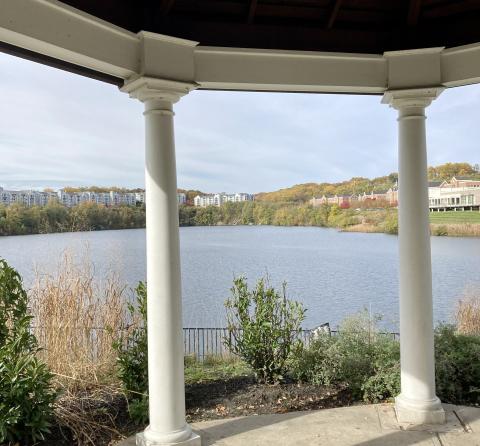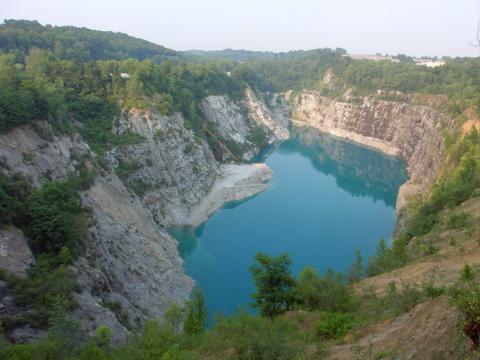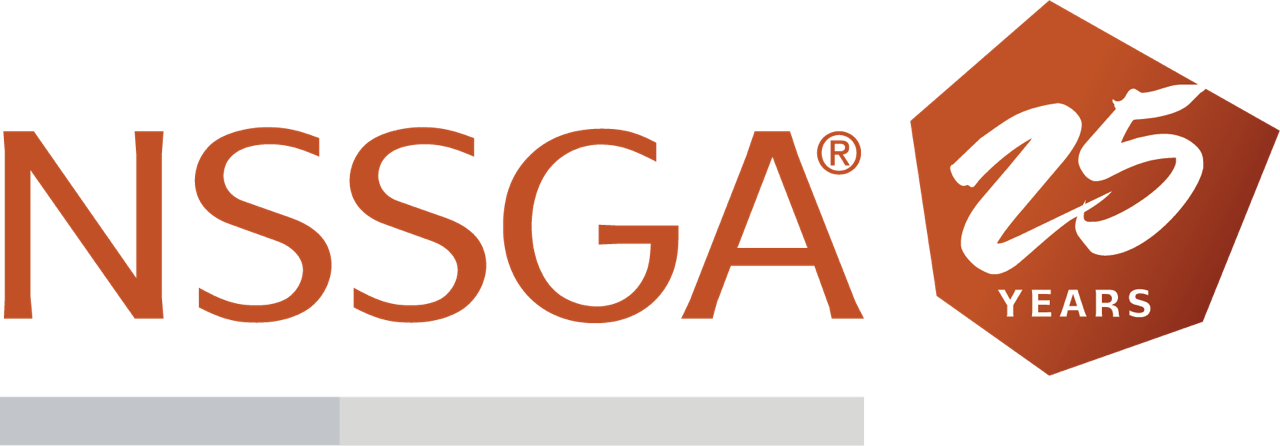Wait For It… A Quarry Community 150 Years in the Making
By Libby Pritchard, NSSGA
On it surface, Quarry Lake at Greenspring is the model of a modern, vibrant, mixed-use development. The main road into the 270-acre community is flanked on one side by boutique shops, restaurants and offices; on the other side is a park, a lake with a walking trail and homes atop a ridge. However, when you dig a little deeper into the development’s past, you will find it has a unique story to tell and is far more than just another modern development.
The roots of Quarry Lake at Greenspring date back to the Civil War. In the mid-1800s, the ground was first broken for mining at what would someday be called Greenspring Quarry. It is said that the railroad ballast came from the quarry to build railroads used for transporting supplies to support the war effort. Following the war, the quarry played a key role developing the Baltimore region. It provided materials for the Beltway, iconic buildings such as the National Aquarium and the baseball stadium at Camden Yards.
By the mid-1980s, the greater suburbs of Baltimore had started to encroach on Greenspring Quarry, and friction began to build between the local community and management around the usual suspects: truck traffic, noise and dust. Serendipitously, around that same time, management of the Arundel Corporation started thinking about the future of the quarry—its long-term future.
"Management knew there was a limited life for the quarry and recognized there was an opportunity for waterfront property," said Johnny Johnsson, environmental manager with Vulcan Materials.
The creation of waterfront property was especially premium at the time because a project in North West Baltimore County to dam a creek and create a lake had recently been denied. It was this strategic thinking decades before the site would become Quarry Lake at Greenspring that ultimately made its creation possible.

The quarry operators quickly got to work in the 1980s reaching out to community members, local organizations and politicians. Ultimately, they negotiated a win-win reclamation plan for the company and the people of Baltimore County. The plan included the sequential closure of various lines of the business which included the asphalt plant in 1986, the ready-mix concrete plant in 1992 and quarrying would stop in 1999, which was around the projected time reserves would be exhausted. In exchange for closing their operations, the company’s reclamation plan was signed and approved to create 600 housing units.
Getting the initial reclamation plan approved was the first step in a very long journey to the quarry’s final state. There were details to consider like community design and the best way to fill the quarry in with water, plus regulatory agencies to work with. Furthermore, the quarry changed hands two times since the initial plan was set in place—first it was purchased by Florida Rock in 1988 and then by Vulcan Materials in 2007.
But throughout all the changes and challenges, each company maintained the vision and believed in Greenspring Quarry’s value. Each new owner was a champion for the project and kept the process moving, which is essential for any enhancement reclamation project to succeed, especially one of this scope.
"You have to have a champion to work with people who can carry the ball every down because there will be twists and turns along the way," said Johnsson.
One of Greenspring Quarry’s key champions was Steve Koren, the original developer brought in by the Arundel Corporation who worked with all three owners over the course of the quarry’s development. Thanks to Steve, another key champion was hired to further the vision of the quarry: Rick Hoehn, a landscape architect and land planner with Daft-McCune-Walker.
As the lead designer and project manager of Quarry Lake at Greenspring, Rick Hoehn mediated between "the three Cs": county, company and community, for ten years.
"It was a rigorous process working through the project’s many phases and a labor of love. We also branded our process: Value Reclamation Planning—The Transformation from Quarry to Place," said Hoehn.

Though the transformation from quarry to place was long and arduous, the end results speak for themselves. The Quarry Lake at Greenspring is a true success. It is thoughtfully designed to showcase the 40-acre, 360-foot-deep quarry-turned-lake. It provides amenities to residents and visitors including a park, shopping and walking path. It also supports the environment through stream restoration and wetland creation. It’s no surprise that in 2008 it won a National Mine Reclamation Award from the Interstate Mining Compact Commission.
There are many other paths to reclaim quarries, give them a new life, and turn them into community gems.
"After Quarry Lake at Greenspring, we moved on to a second Baltimore area quarry known as Delight Quarry, now Quarry Place, with my own firm Hoehn Landscape Architecture and now with KCI Technologies," said Hoehn. "Value Reclamation Planning has now spread its wings into other parts of Maryland, Pennsylvania, and the Bahamas."
Although to most visitors Quarry Lake at Greenspring may be just another modern mixed-use development, to those who know its history, it captures the legacy of aggregate mining. Greenspring Quarry started in the Civil War, laid the foundation of Baltimore’s infrastructure, provided meaningful, good-paying jobs to employees for decades, brought communities, private industry and government together in collaboration, and finally provided homes (lakefront property in the middle of Maryland) for thousands of people. Throughout the life cycle of a quarry—before it’s developed, during extraction, and upon reclamation—the land provides for the local community, and that is the legacy of mining.
Originally published in March/April 2023 Stone, Sand & Gravel REVIEW.

